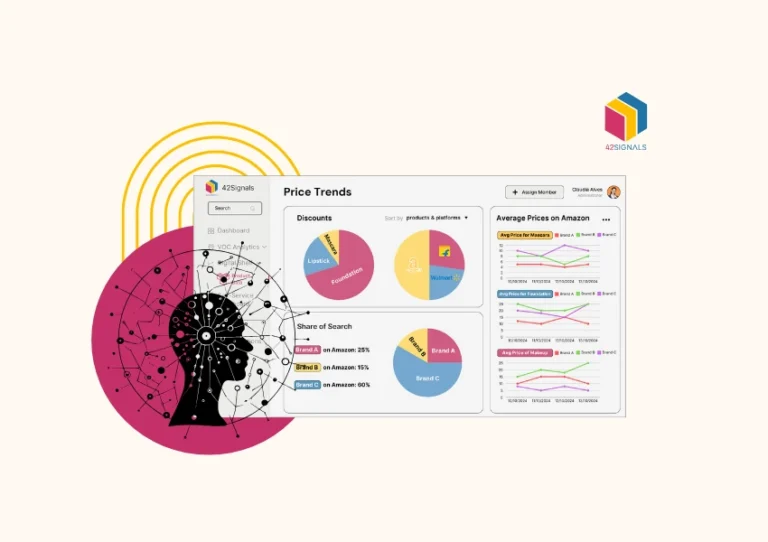Pricing teams today are overwhelmed by data. Competitor price trackers dump spreadsheets, MAP compliance tools bombard inboxes with alerts, and someone is always requesting a “heatmap thingy” for tomorrow’s leadership meeting. But here’s the kicker: 73% of companies admit they’re still setting prices based on gut feelings (2023 Retail Insights Report). It’s time to change that with competitive pricing data.
In this article, we’ll show you how businesses are using tools like 42Signals to outmaneuver rivals, while staying on the right side of MAP compliance.
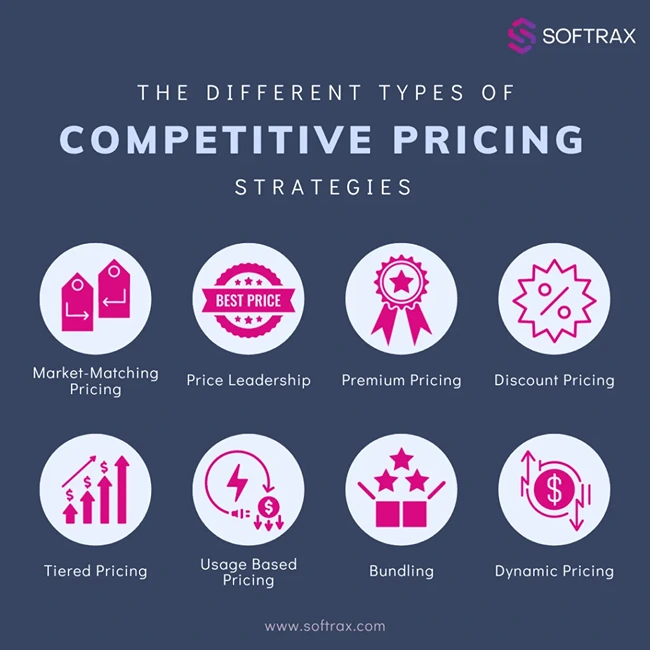
Image Source: Softrax
The Benefits of a Competitive Pricing Data Dashboard
Picture this: It’s 3 PM on a Tuesday. Your biggest competitor just slashed prices on your top-selling product. Your sales team is in panic mode. But instead of reacting impulsively, you open up your pricing dashboard—a live feed that combines competitor prices, your margins, and how many products have been sold in the last week.
This actually happened to a Milwaukee-based tool supplier last quarter. Their custom-built dashboard (using Power BI + Python) flagged a Home Depot price drop on industrial drills within 15 minutes. Instead of immediately discounting, they checked two things:
- Their elasticity heatmap, which showed that Midwest contractors weren’t swayed by a $20 price difference.
- A competitor analysis dashboard revealed that Home Depot was clearing out old inventory.
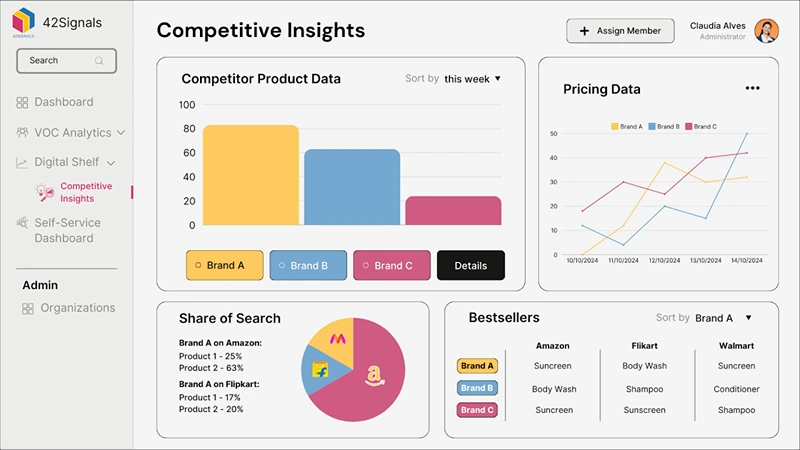
The result? They held their prices steady, launched a “Free Safety Gear Kit” promo instead, and maintained 92% of their sales.
Pro Tip: Ditch the one-size-fits-all dashboard. Good tools are designed to suit your needs and give you the right information you need at your fingertips.
Why Your Grandma’s Price History Matters
The saying “Those who don’t study history are doomed to repeat it” rings especially true when it comes to pricing. Let’s talk about a real mess: A Texas BBQ chain tried dynamic pricing by raising brisket prices during peak dinner hours last year. The result? Disaster. Why? They ignored five years of data showing their loyal customers would rather wait an hour than pay an extra $2.
3 Ways to Mine Historical Gold:
- The “Oops” Report: Every quarter, review pricing moves that didn’t work. A baby gear brand realized that their 2021 4th of July diaper sale cost them $200K in margin, because newborns don’t care about fireworks-themed sales.
- Competitor Tell-Tales: When Apple Watch launched, Fitbit used Best Buy’s historical holiday markdowns to time their counter-promotions.
- MAP Violation Patterns: A sneaker company found that 80% of unauthorized discounts occurred when new college reps hit the field every August. Now, they run MAP compliance boot camps in July.
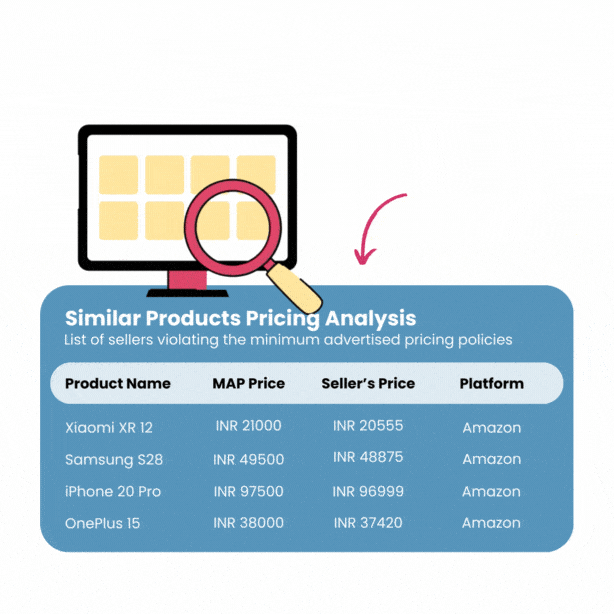
MAP Compliance: How to Play Nice Without Getting Played
Minimum Advertised Price policies aren’t just legal mumbo jumbo, they help businesses track what’s happening to their products by their sellers. Take it from a piano retailer who almost went under:
“We let Amazon sellers chip away at our $1,299 keyboard MAP for months,” the owner told me. “By the time we noticed, ‘Google Shopping’ was showing our product as ‘normally $799’—even though we never sold it that low. It took 18 months to fix that perception.”
The MAP Compliance Cheat Sheet:
- Automate the Grunt Work: Tools like 42Signals scan over 15,000 sites daily for violations. With our advanced data scraping techniques, we can provide the right data on products and violations in real time.
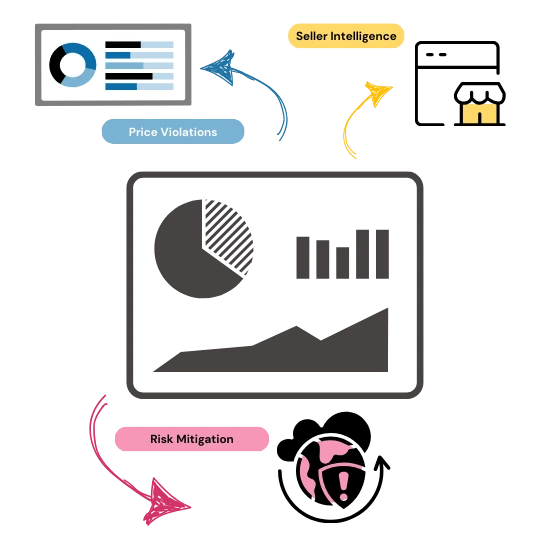
- Play Psychology: Offer MAP-compliant retailers exclusive colors or bundles, like Yeti does with specialty outdoor stores. This is a great way to incentivize good behavior and keep your retailers happy.
- Nuke Repeat Offenders: A kitchenware brand now requires serial MAP violators to prepay for inventory—this has reduced violations by 67%. May be a bit extreme, but a good way to ensure that money isn’t lost on random sales.
The Price Positioning Matrix
Draw a simple 2×2 grid:
- Y-axis: Perceived Quality (Low to High)
- X-axis: Your Price vs. Market Average
This is a great way to identify where your product stands in the market. Looking at an example of a skincare brand performing this analysis, the company –
- Added third-party lab test results to the packaging
- Ran comparison ads against grocery store brands
- Moved to the “Premium Value” quadrant without changing the price
Fun Fact: Trader Joe’s “Cheap Wine That Doesn’t Suck” campaign used this exact strategy to dominate the $8-$12 wine bracket.
Digital Shelf Analytics: The Silent Salesman to Your Competitive Pricing Data
Your Amazon listing isn’t just a page, it’s THE platform for discovery. A coffee company learned this the hard way when their “#1 Organic Cold Brew” disappeared from search results. Why? A competitor dropped prices by 3%, triggering Amazon’s algorithm to favor them.
Key Digital Shelf Metrics to Track:
- Share of Search: The percentage of the top 10 search results you own. This is how customers discover you. If you’re not on the first page of the search results, the chances of potential consumers finding your products dwindle.

- Image Hotspots: Where users click on product photos. This data can be sourced from your website with tools like Hotjar and helps understand what customers like and dislike about the product before adding it to the cart. This knowledge can then be replicated to other platforms like Amazon or Walmart.
- Review Keywords: A skincare brand found that the word “non-greasy” in reviews allowed them to raise prices by 8%. Nobody wants greasy skin, and just adding that term made the item more popular to consumers looking for the same product. Try using 42Signals to learn about keyword suggestions for your brand.

Competitor Dashboards That Don’t Put You to Sleep
Most competitor dashboards are just messy charts. The good ones are simple and effective. A golf gear maker tracks:
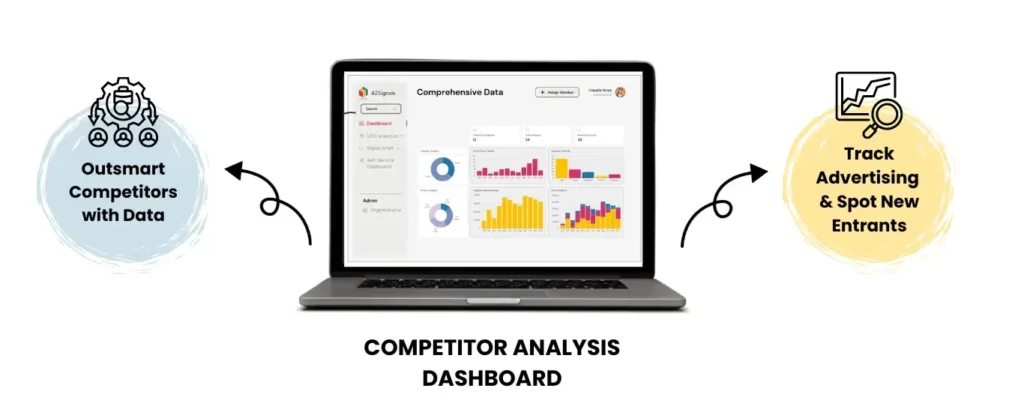
- Real-Time Alerts: When Dick’s Sporting Goods runs a “Buy Clubs, Get Bags Free” deal.
- Social Listening: Reddit threads complaining about competitor putters.
- Gray Market Watch: Monitoring Facebook Marketplace, they found 200 drivers being sold for $150 (well below retail).
Putting It All Together: The Pricing Strategy Stack
- Use smart tools like 42Signals to understand when competitors change their pricing and how to adapt to these dynamic fluctuations. Sign up for a free trial today.
- Keep a close eye on map violations that can easily dilute a brand’s reputation and damage your brand’s credibility.
- Regularly apprise your products on all marketplaces to ensure that nothing is missed or underperforming in comparison to your competitors.
Competitive Pricing Data > Manual Data Tracking
Forget manual data tracking and focus on competitive pricing data. The best pricing strategies blend historical patterns with street-smart experimentation. Start small: Pick one product, build a simple dashboard, and test just one tactic from this article. We are here to help you with your pricing strategies by doing the heavy lifting for you. Schedule a free demo to find out more.

